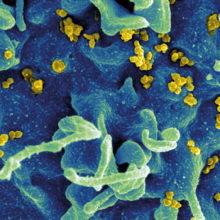Editorial
Issue: HIV and AIDS
06 November 2018 article

Welcome to the November edition of Microbiology Today, an edition which considers how human immunodeficiency virus (HIV) and acquired immunodeficiency syndrome (AIDS) impacts people across the world. HIV and AIDS are a major global health threat, affecting millions of people; however, with on-going research significant progress has been made in our ability to prevent, diagnose and treat HIV and AIDS. In this edition, our authors reflect on the ways in which the understanding of this virus and disease have changed across the years, the associated complications and what the future outlook might be.
The issue opens with Paul Hine giving us an overview of the global HIV situation as it stands in 2018, explaining how advances in scientific research and understanding over the last decade have led to changes in preventing infection and treating HIV. Paul gives us an insight into how this disease can affect a wide variety of people and impacts on the lives of these individuals in diverse ways. He discusses the targets set by the Joint United Nations Programme on HIV and AIDS and provides a framework outlining what steps will need to be implemented to ensure we meet those goals by 2020.
Next, Gary Murphy, Colin S. Brown, Daniel Bradshaw, John Saunders and Noel Gill bring us up-to-date with the latest developments in pre-exposure prophylaxis. Discussing the issues surrounding atypical results caused by the increased use of this strategy, they highlight which of these atypical results could be indicators for retesting. They suggest that diagnostic methodology might need to adapt in the future to account for these new developments. They also emphasise that due to the changes in test results being seen, it will be essential to share experiences to find the testing strategies that lead to the best outcome for individuals moving forward.
Yvonne Gilleece explains how the advancements in available antiretroviral treatments, coupled with a series of interventions, such as opt-out for antenatal screening, have impacted on the outcomes of those who go through pregnancy with HIV. The use of these interventions has led to a huge drop in transmission of HIV from mother to child, with an undetectable viral load in the mother being a key determinant in reducing likelihood of transmission. The future outlook for pregnant mothers is an increasingly positive one; as evidence-based interventions continue to improve the outcomes for this population.
Discussing the challenges that the opportunistic fungal pathogen Cryptococcus can carry for those with HIV and AIDS, Xin Zhou, Robin C. May and Elizabeth R. Ballou outline which members of this genus are the biggest risks and explain how they invade. Our authors provide an insight into why this fungus is such a serious risk. In the wrong situation it can be fatal and lead to both cryptococcal pneumonia and cryptococcal meningitis. Resistance to anti-fungal agents can develop, and as research has now shown novel ways in which this pathogen can evade the immune system, it is clear that continued research will be essential to help improve our understanding of the diseases caused by this pathogen.
Another microbial risk for those with HIV is the possibility of co-infection with the hepatitis C virus. As dual infection with these two viruses is a common occurrence in those with HIV and AIDS, understanding the way in which they impact on health outcomes is imperative. Emma Thomson talks us through dual infection, outlining how these two viruses impact on the host immune system, and, in doing so, how they can potentially accelerate the progression to liver cirrhosis and cancer.
The Comment piece in this edition has been provided by Robin Weiss, and he evaluates where we are in our quest for a vaccine to HIV. Robin outlines some of the challenges that this virus presents in the on-going effort to design a vaccine. The development of a vaccine to successfully combat the ever-shifting antigenic profile of HIV is a complex process, but as research progresses there is hope that by utilising antibody and cellular immunity, some level of protection could be possible in the future.
Rowena Jenkins
Editor
[email protected]
Image: Coloured SEM of HIV particles infecting a human T cell (blue). National Institute of Allergy and Infectious Diseases, National Institutes of Health/National Cancer Institute/Science Photo Library.
